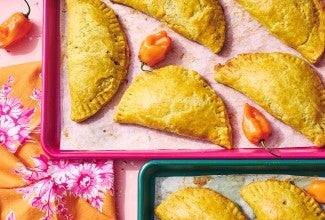-
To make the filling: Use a peeler to remove the rind in thin, long strips from the orange and lime. Try to harvest only the outer layer of skin (i.e.: zest) and not any of the white pith beneath. Set the strips of rind aside.
-
Use a sharp paring knife to slice away the white pith from the orange and lime, then discard the pith. Cut out the whole segments of orange and lime, leaving behind the membranes (this is also known as “supreming” the fruit). Place the strips of rind and any seeds in cheesecloth and tie with kitchen string.
-
Place the orange and lime segments in a medium saucepan. Then add the pineapple and dark brown sugar. Place the cheesecloth with the rind and seeds into the pot with the fruit; cooking the rinds and seeds with the fruit infuses more flavor into the filling. Cook the fruit over medium-high heat until the mixture starts to boil and you see a considerable amount of juice in the bottom of the pan, about 5 to 6 minutes.
-
Reduce the heat to medium-low and cook, stirring occasionally, until the pineapple looks caramelized, the orange and lime segments have broken down, and the remaining juice has turned into a runny syrup in the bottom of the pan, about 1 hour. Remove the pan from the heat, discard the cheesecloth bundle, and set aside to cool completely. While the filling is cooking, prepare the dough.
-
To make the dough: In a medium bowl, whisk together the flour, dark brown sugar, and salt.
-
Add the butter and shortening and toss to coat in flour. With a pastry blender, two knives, or your fingertips, cut or rub the fat into the flour mixture until it resembles cornmeal.
-
Sprinkle 3 tablespoons (43g) of the ice water over the flour mixture, and lightly toss to combine. If the dough does not hold together when squeezed in your hand, sprinkle in the additional tablespoon of water and mix to combine until the dough is just wet enough to hold together. A few dry or crumbly bits are OK at this stage.
-
Form the dough into a disk, wrap in plastic or your favorite reusable wrap, and refrigerate for 30 minutes or up to overnight.
-
To shape and fill the empanadas: Once the filling has cooled and the dough has chilled, remove the dough from the refrigerator. Divide the dough into 9 equal portions (about 39g each), form them into rough balls, and place them on a parchment-lined baking sheet. Cover the dough with a lint-free kitchen towel and allow them to rest for 10 to 15 minutes at room temperature.
-
Preheat the oven to 350°F with a rack in the center position.
-
Lightly dust your counter with flour. Fill a small bowl with cool water; set aside. Use a rolling pin to shape one dough ball into a roughly 5" circle (about 1/8" thick), rotating the dough a quarter turn (90°) between rolls to achieve the roundest shape possible.
-
Spoon a very generous tablespoon of pineapple filling onto the center of one dough round; a tablespoon scoop is a helpful tool here. Use your fingers or a brush to apply a thin layer of water around the edge of half the circle of dough. Fold the other half of the dough over the filling to form a semicircle. Press with a fork to seal closed. Place the empanada back on the parchment-lined baking sheet, cover it with the kitchen towel, and repeat with the remaining dough and filling.
-
To bake the empanadas: Remove the kitchen towel and brush the empanadas with the egg wash. Sprinkle each with the Cinnamon Sugar Plus. Bake the empanadas for 30 to 35 minutes, or until light golden brown. Serve warm or at room temperature.
-
Storage information: Store fully cooled empanadas at room temperature in an airtight container for up to a day; freeze for longer storage. The filling in this empanada recipe can be made up to 3 days ahead and kept in the refrigerator until time to fill and bake. It can be added directly onto the dough without coming to room temperature first.




















